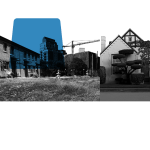For public health departments aiming to address the causes of disease, it should be a no-brainer to get involved in stabilizing housing for vulnerable populations, thereby engaging in preventing residential displacement in gentrifying neighborhoods. Given the many connections between housing and health, public health has an important role to play in ensuring everyone has access to good quality, stable, and affordable housing and neighborhoods.[1]
Yet, Alameda County Public Health Department’s (ACPHD) multipronged approach to addressing displacement and gentrification is rare, to say the least. Why haven’t more health departments become involved in these issues?
Housing affordability and stability are perhaps the most difficult issues in city planning, rooted in the historical primacy of private property and landowners’ rights to make a profit.
The current affordable housing crisis requires an interdisciplinary and people-centered perspective. Public health can offer that perspective. I explore 4 hypotheses for why public health has, for the most part, stayed out of gentrification and displacement debates, and I offer some ways forward from the current state of inaction.
Researchers and advocates argue that looking at the social determinants of health has helped shift the public health lens, encouraging the field to address contextual factors such as neighborhood conditions. But this movement has not resulted in widespread action on the basic building blocks of neighborhoods: housing.
My first, generous hypothesis is that public health departments addressing systemic health inequities have decided to first tackle the low-hanging fruit, issues everyone can agree on and problems with clear solutions. Housing affordability and stability are perhaps the most difficult issues in city planning, rooted in the historical primacy of private property and landowners’ rights to make a profit.
But if we’ve learned anything from our planning efforts, it’s that there is no such thing as low-hanging fruit. Planning decisions are inherently political, and even seemingly obvious and simple solutions — like opening up school playgrounds — are fraught with debate, bureaucracy, and funding hurdles. When it comes to housing, we can apply the lessons learned from public health’s successful work on other built-environment issues. Solutions include partnerships, use of data and analysis to support policy, and highlighting the health impacts of actions to achieve healthy and equitable outcomes.
Which brings me to my second hypothesis: The public health field relies on a positivist epistemology, or the need to quantify issues and demonstrate causality. But when it comes to neighborhood-level phenomena like gentrification, it becomes difficult to assign the level of confidence in the causality that researchers desire. The data we would need to demonstrate a causal relationship between gentrification, displacement, and poor health are usually unavailable; data on where and why people move, in addition to their health status, are difficult and costly to collect.
To further complicate the scientific evidence, planning practitioners have spent a lot of time trying to show the benefits of gentrification[2] rather than studying the negative consequences. Both public health and planning practitioners and researchers have a history of pathologizing poor neighborhoods and communities of color, assuming that the ills of these communities are due to poor choices rather than systems of inequity, which thereby lead to policy solutions that look a lot like gentrification. Yet if we were to see the systemic injustices in our society, communities of color and low-income people would not be seen as a social ill in and of themselves.
Nevertheless, research on the health impacts of housing instability is well established[3] and sufficient to justify engagement in policy and action to stabilize housing. In addition, research on the links between gentrification and negative health outcomes is emerging.[4] Furthermore, there is evidence that when low-income households are displaced from gentrifying neighborhoods, they move to even more disadvantaged neighborhoods,[5] which presents additional health risks. The public health field often acts when evidence is emerging. The time is ripe to engage in gentrification and displacement. Not only is such action supported in our legal structures (e.g., rational basis test), it’s also often impossible to gather evidence until action has been taken (e.g., you can’t prove the health benefits of a soda tax until one is adopted).
Health departments can work collaboratively with other government agencies to support the stabilizing features of code enforcement while protecting tenants against the unintended negative consequences of rent increases, evictions, and landlord harassment.
My third hypothesis involves the potentially opposing goals of improving housing conditions and ensuring affordability. ACPHD described how the asthma program shed light on code enforcement. Although it is illegal in many places for landlords to evict tenants because they complain about code violations, these evictions occur, and such evictions can result in housing instability, especially if landlords evict tenants in retaliation.
Some cities have cracked that nut as well. Los Angeles’ Systematic Code Enforcement Program, for instance, proactively inspects rental units and removes the burden from tenants to report their landlords. San Francisco’s Code Enforcement Section works with community-based organizations to ensure tenants are protected before code enforcement officers step foot in the unit. Health departments can work collaboratively with other government agencies to support the stabilizing features of code enforcement while protecting tenants against the unintended negative consequences of rent increases, evictions, and landlord harassment.
My last hypothesis rests on the fact that health departments are usually situated in a risk-adverse government structure that has little say about the local jurisdiction’s land use and housing actions. It seems Alameda County’s location in the smoking-hot Bay Area housing market has encouraged the department to get involved. The leadership and vision that have inspired ACPHD’s housing work are examples of what other health departments can, and should, do. The department provides the kind of forward-looking and risk-taking attitude needed for health departments to engage effectively in gentrification and displacement. Given that the direct funding streams to work on housing stability may not be as readily available as other issues like tobacco or injury prevention, it takes strong leaders to knit together resources from diverse programs to address this important matter.
Whatever the reason for their absence, public health departments should look to Alameda County and other jurisdictions, like King County, as vanguards. They’re engaging in very sticky issues like housing affordability and stability. Especially during this time of extreme political uncertainty, providing housing security is a key way to protect the most vulnerable among us.
Using the lessons learned from public health achievements and healthy city planning successes, we can take advantage of existing and emerging evidence, foster partnerships among governmental and non-governmental agencies, and embrace a risk-taking leadership style. Public health agencies have many tools at their disposal to engage in preventing displacement and ensuring housing stability for vulnerable communities.
[1] Krieger and Higgins, “Housing and Health”; Dunn, “Housing and Health Inequalities.”
[2] Duany, “Three Cheers for Gentrification.”
[3] Jelleyman and Spencer, “Residential Mobility in Childhood and Health Outcomes.”
[4] Huynh and Maroko, “Gentrification and Preterm Birth in New York City, 2008–2010”; Gibbons and Barton, “The Association of Minority Self-Rated Health with Black versus White Gentrification”; Fullilove, Root Shock.
[5] Ding, Hwang, and Divringi, “Gentrification and Residential Mobility in Philadelphia.”
Miriam Zuk, PhD, is a member of the BLOCK Project’s Community of Practice and Director and Senior Researcher at the Center for Community Innovation.

